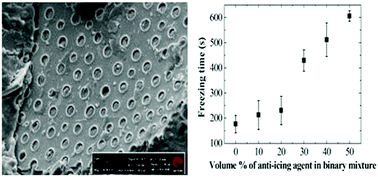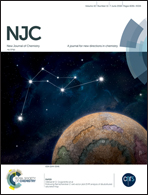Anti-icing agent releasing diatomaceous earth/SBS composites†
Abstract
Diatomaceous earth (DE) loaded SBS based composites were developed for anti-icing applications. 30% by weight DE containing SBS composites were filled by keeping the composites in anti-icing agent (EG or PEG) solutions in diethyl ether/acetone binary mixtures. The dissolved anti-icing agents penetrated into the swollen DE/SBS matrix in the binary mixture. DE particles served as the anti-icing agent carrier in the hydrophobic SBS matrix. The amount of anti-icing agent retained in the composite was increased by increasing the concentration of the anti-icing agent in the binary mixture, which resulted in longer freezing times of water droplets on the composite. The effective anti-icing mechanism was shown to be the release of the anti-icing agent upon contact with water and subsequent decrease of the water freezing temperature. The release of PEG in the inner DE pores was achieved by cutting the composite films into smaller pieces and increasing the water/composite interfacial area. This shows that the developed composites maintain their anti-icing activity for longer times in the presence of scratches and wear. Scratches and wear allow the anti-icing agent filled pores of DE particles buried in the SBS matrix to be exposed to the top surface with the possibility of new anti-icing agents being released when in contact with water.



 Please wait while we load your content...
Please wait while we load your content...